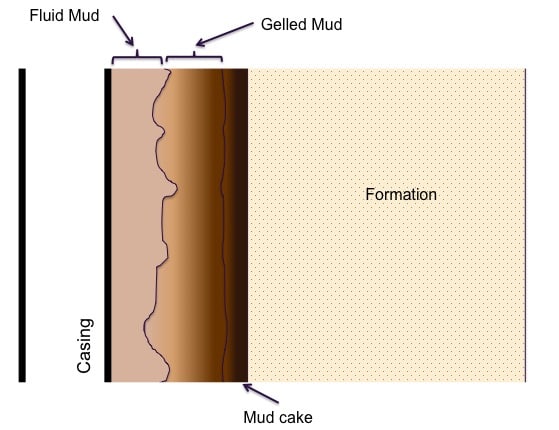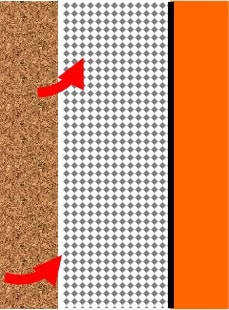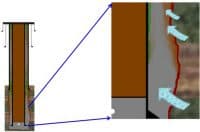First of all, I would like to define what Gas Migration is, from an acceptable industry reference:
“Gas migration is the invasion of formation fluids (gas in this case) into the annulus due to a pressure imbalance at the formation face, where the fluids (gas) may migrate to a lower pressure zone or possibly to the surface”.
Following primary cementing, it can be ‘logical’ to think that, if we see gas at the surface, this gas is ‘migrating’ through the cement slurry. This migration could be probably due to, (and this is the accepted theory), an imbalance between the formation pore pressure and the annular pressure; created during the transition time of the cement.
The definition of ‘transition time’ is the time when the cement slurry is no longer a liquid, capable of transmitting hydrostatic pressure, but is not yet solid, and able to bond and isolate the formation. During the transition time, the solid content in the cement slurry becomes self-supported as a result of hydration (gelled structure), and the remaining porosity filled with water-like fluid becomes underbalanced with the formation pore pressure.
Typical methods to prevent this from happening, involve a cement additive to either viscosify the resulting fluid inside the porosity or lower the porosity itself. We consider this a mitigation measure because in both cases the ‘root cause’ (underbalance during the transition period) is not removed; instead, the focus is in ‘stopping’ gas from moving through the gelled cement.
It is important to mention that, this is the FIRST truth, gas migration through gelled-cement only happen if the cement is in contact with the formation (gas source). In other words, liquid-flowing cement was able to displace mud from the hole. For a minute let’s think was is ‘the mud’ to be removed:

- Flowing mud
- Gelled mud
- Mud filter cake
The thickness of both the gelled mud and filter cake are governed by the permeability of the mud cake (related to mud fluid loss) and the formation permeability. The existence of these two mud zones occurs both in static and dynamic conditions.
If the well is conditioned correctly, most of the gelled mud is removed during the pre-job circulation and cementing operation, while the mud filter cake is removed mainly during cement placement (if the cement design is correct). However, in cases when the mud is unable to form an impermeable filter cake properly, the gelled zone persists during the cementing operation forcing channelling and incomplete cement coverage.
Now coming back to gas migration, and this is the SECOND truth, it should be clear that proper cement coverage is fundamental to prevent gas migration. It is actually, what makes sense when a gas migration control slurry is used (high cost). In other words, if the proper placement is not happening, any fancy gas migration control slurry used, is a waste.
Let’s review the path for gas migration after primary cementing or through cement:

- Through the cement Matrix
- Liquid slurry – Underbalance
- Transition Period during setting – Reason to use a cement slurry for gas migration control
- After setting – Cement Integrity
- Through the Cement-Formation interface
- Unremoved mud filter cake
- Cement Slurry fluid loss
- Unremoved gelled mud – deteriorates with time
Most of the gas migration paths are related to cement slurry properties, and that is the focus for most people. Let me mention one thing here before I continue; and why not let’s call it the THIRD truth: Just because we use a gas migration control additive, it does not mean that the slurry can control gas.
The other two paths for gas migration are related to the mud and cement placement. Some people, even cementing engineers, do not pay enough attention to this and it is perhaps the most important element. This is the FOURTH truth: Pay attention to cement placement and channelling prevention (including rheology, rates, compatibility, friction pressure – for cementers; and rheology, API fluid loss – for mud engineers).
Coming back to gas migration during the transition period of the cement slurry, I mentioned that using gas migration control chemicals is an action to mitigate the risk. Now let’s talk about prevention, for me the best way to understand what are our alternatives to prevent gas migration (lower the probability) is by looking at the below equation:

CSGS is the static gel strength of the cement that results in the decay of hydrostatic pressure to the point at which hydrostatic pressure equals pore pressure
OBP is hydrostatic annular pressure minus the pore pressure,
L is the length of the cement column above the flow zone,
DOH is the diameter of the open hole
DCSG is the outer diameter of the casing
You can find this equation and a detailed explanation in API STANDARD 65 – PART 2, Isolating Potential Flow Zones During Well Construction, Dec. 2010. This is highly recommended reading material.
What you need to understand from this equation is that the lower the CSGS, the higher the chances of gas migration happening. Mainly when CSGS is lower than 250 lbf/100ft2, the risk of gas migration is high. Looking at the equation, the following are valid assertions:
- The longer L, the higher the risk of gas migration;
- The lower OBP, the higher the risk of gas migration
- The wider the annular gap, the lower the risk of gas migration
Cement length, L, has a more significant influence in this equation. This is the FIFTH truth: choose your TOC wisely.
I almost forgot, what happens if the job objective requires a low CSGS value? In this case, you need a gas migration control slurry. Correct?. However, I said that just because we use a gas migration control product, it does not mean that the slurry is always able to control gas.
So, what is the requirement?. Well if you CSGS is low, you need a cement slurry able to make it higher, in other words, a cement slurry able to develop static gel strength.
We measure static gel strength development, as a cement slurry property as CGSP, Critical Gel Strength Period. CGSP is defined as the time between the development of the critical static gel strength (CSGS) and a static gel strength of 500 lbf/100 ft2. At this last value, 500 lbf/100 ft2, it is accepted that gas cannot move. This transition needs to happen in less than 45 min, as per the API STANDARD 65 – PART 2, for the cement slurry to be considered able to control gas migration.
As you can see, the requirement does not mention the use of gas migration control products. However, they are probably the easiest way to trigger a sufficiently rapid gel strength development, the concentration and chemical nature plays a crucial role. This is the SIXTH truth: Next time ask your cementing contractor for the Static Gel Strength Development test/chart and look for this transition to be less than 45 min.
I hope you can find this post useful, and if you have any comments or questions, please let me know.
Cheers
L. Diaz



Thank you Lenin for the details. There’s also the mud-push or Spacer properties and volume and the compatibility between the well-fluid and Cement Slurry.
Thanks for your input, Yahia
Pls read my page and comments on your post
Sure, Dr Rabia. I just enjoyed very much the conversation in your esteemed group. All, this conversation can be seen in: https://www.facebook.com/groups/333461463664660/
can you please explain when do we need reduced CSGS? I could not understand this point.Thank you.
Thanks for your question Shah.
Sometimes the job objective calls for the TOC to be at surface (intermediate casings) or to cover certain portion of the previous casing. In these cases, the L factor in the equation would be large enough to make CSGS low or lower than 250 lbf/100ft2.
In this situation We know that the risk of gas migration is high, but we need to meet the job objective (high TOC = Low CSGS). So, in this case we need to design proper gas migration control slurry, as the post says.
Hope this explains it a bit better, if not. Please let me know
Cheers,
L. Diaz
Please confirm if you agree with my paradigm for Lead & Tail cement design. To achieve success the annulus hydrostatic pressure needs to be greater than pore pressure of gas zone with flow potential (permeability), at all times. This is easy to achieve when circulating or static with sufficient mud weight, and typical cement slurries.
The challenge is to design a cement slurry to provide sufficient hydrostatic pressure when the Tail Cement transitions, and during this period of time, does NOT provide any hydrostatic pressure. Hence during Tail transition, the hydrostatic pressure from the Lead needs to alone be sufficient to overbalance the formation pore pressure. Is this correct?
Once the Tail Cement sets up, it becomes effectively solid and will prevent gas to flow into the cement, creating an effective annular barrier.
Many wells exist where gas zones with permeability were drilled, but cemented with either only Lead, which can allow gas to flow to surface during and after the transition phase.
Is this a correct way to view the issue and potentially mitigate Sustained Annular Casing Pressures? Thanks in advance.
Hi Gerald,
Yes all the fluids capable to transmit hydrostatic pressure over the cement slurry while setting in from of a gas zone will act to prevent gas migration, typical case a liner job.
A lead slurry, designed in such a way that it remains liquid, while the tail is already with enough SGS, will help
Hello; Since fluids/gas ONLY moves from High Pressure to Lower Pressure areas, and “OBP is hydrostatic annular pressure minus the pore pressure” , a KEY solution is to DESIGN the cement job such that when the Tail Transitions, and has NO effective Hydrostatic Pressure, that the rest of the column has hydrostatic pressure greater than any formation pore pressure.
If we can keep the hydrostatic from going under-balanced, then there will be no gas migration into the wellbore annulus, hence better cement jobs. This is not always possible but believe per technical studies, 90% of the time this will work. Failure to do so is what I can ‘failure by design’, since if we design a job with only tail slurry and it all transitions at the same time, the wellbore hydrostatic goes to near 0 psi, full underbalance, and we SHOULD expect the well to flow – gas/hydrocarbons to come into the wellbore.